HSD11B2
-
Official Full Name
hydroxysteroid (11-beta) dehydrogenase 2 -
Overview
There are at least two isozymes of the corticosteroid 11-beta-dehydrogenase, a microsomal enzyme complex responsible for the interconversion of cortisol and cortisone. The type I isozyme has both 11-beta-dehydrogenase (cortisol to cortisone) and 11-oxoreductase (cortisone to cortisol) activities. The type II isozyme, encoded by this gene, has only 11-beta-dehydrogenase activity. In aldosterone-selective epithelial tissues such as the kidney, the type II isozyme catalyzes the glucocorticoid cortisol to the inactive metabolite cortisone, thus preventing illicit activation of the mineralocorticoid receptor. In tissues that do not express the mineralocorticoid receptor, such as the placenta and testis, it protects cells from the growth-inhibiting and/or pro-apoptotic effects of cortisol, particularly during embryonic development. Mutations in this gene cause the syndrome of apparent mineralocorticoid excess and hypertension. -
Synonyms
HSD11B2;hydroxysteroid (11-beta) dehydrogenase 2;corticosteroid 11-beta-dehydrogenase isozyme 2;SDR9C3;short chain dehydrogenase/reductase family 9C;member 3;Corticosteroid 11 beta dehydrogenase isozyme 2;11 beta HSD2;11 beta hydroxysteroid dehydrogenase type 2;11 DH2;11-beta-HSD2;11-beta-hydroxysteroid dehydrogenase type 2;11-DH2;AME;AME1;DHI2_HUMAN;HSD11K;HSD2;Hydroxysteroid 11 beta dehydrogenase 2;Hydroxysteroid 11 beta dehydrogenase isoenzyme 2;NAD dependent 11 beta hydroxysteroid dehydrogenase;NAD-dependent 11-beta-hydroxysteroid dehydrogenase;Short chain dehydrogenase/reductase family 9C, member 3;OTTHUMP00000174801;short chain dehydrogenase/reductase family 9C member 3
Recombinant Proteins
- Human
- Zebrafish
- Rat
- Mouse
- E.coli
- Mammalian Cells
- HEK293
- Wheat Germ
- Yeast
- In Vitro Cell Free System
- GST
- His
- DDK
- Myc
- Non
- Avi
- Fc
- Flag
Background
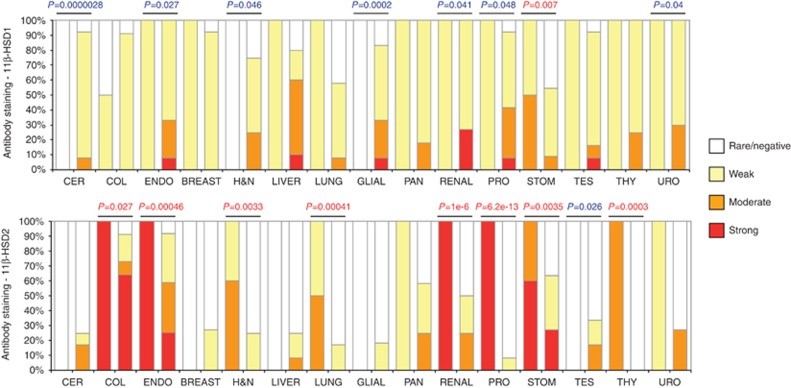
Fig1. Staining intensity of 11β-HSD1/2 using a publicly available data set featuring 15 different normal/malignant tissues was computed and illustrated by histogram. (Nicola Cirillo, 2017)
What is HSD11B2 protein?
HSD11B2 (hydroxysteroid 11-beta dehydrogenase 2) gene is a protein coding gene which situated on the long arm of chromosome 16 at locus 16q22. There are at least two isozymes of the corticosteroid 11-beta-dehydrogenase, a microsomal enzyme complex responsible for the interconversion of cortisol and cortisone. The type I isozyme has both 11-beta-dehydrogenase (cortisol to cortisone) and 11-oxoreductase (cortisone to cortisol) activities. The type II isozyme, encoded by this gene, has only 11-beta-dehydrogenase activity. In aldosterone-selective epithelial tissues such as the kidney, the type II isozyme catalyzes the glucocorticoid cortisol to the inactive metabolite cortisone, thus preventing illicit activation of the mineralocorticoid receptor. The HSD11B2 protein is consisted of 405 amino acids and its molecular mass is approximately 44.1 kDa.
What is the function of HSD11B2 protein?
HSD11B2 catalyzes the conversion of biologically active 11-beta-hydroxyglucocorticoids (11beta-hydroxysteroid) such as cortisol, to inactive 11-ketoglucocorticoids (11-oxosteroid) such as cortisone, in the presence of NAD(+). It acts as a dehydrogenase (oxidase), thereby decreasing the concentration of active glucocorticoids, thus protecting the nonselective mineralocorticoid receptor from occupation by glucocorticoids. In tissues that do not express the mineralocorticoid receptor, such as the placenta and testis, it protects cells from the growth-inhibiting and/or pro-apoptotic effects of cortisol, particularly during embryonic development.
HSD11B2 Related Signaling Pathway
HSD11B2 is involved in many biological processes, including aldosterone pathway, anti-inflammatory pathway, angiotensin converting enzyme (ACE) pathway, Wnt/β-catenin pathway, etc., corresponding to the regulation of related biological physiological processes. On the other hand, the p38 MAPK signaling pathway may be involved in regulating the expression and function of HSD11B2, which is particularly critical in fetal development.
HSD11B2 Related Diseases
Dysfunction of HSD11B2 is associated with a number of diseases, such as Apparent Mineralocorticoid Excess. Its abnormal function may also lead to an increase in the glomerular inflammatory response, or affect the activity of 11β-HSD2 in fat cells, leading to obesity and insulin resistance.
Bioapplications of HSD11B2
Agonists or inhibitors targeting HSD11B2 may serve as potential drug targets for the treatment of hypertension, metabolic syndrome, and inflammation-related diseases. In addition, the expression level of HSD11B2 may also be used as an indicator for the diagnosis and prognosis assessment of related diseases.
Case Study
Case study 1: Nicola Cirillo, 2017
Recent studies have shown that production of cortisol not only takes place in several non-adrenal peripheral tissues such as epithelial cells but, also, the local inter-conversion between cortisone and cortisol is regulated by the 11β-hydroxysteroid dehydrogenases (11β-HSDs). However, little is known about the activity of this non-adrenal glucocorticoid system in cancers.
The presence of a functioning glucocorticoid system was assessed in human skin squamous cell carcinoma (SCC) and melanoma and further, in 16 epithelial cell lines from 8 different tissue types using ELISA, western blotting and immunofluorescence. 11β-HSD2 was inhibited both pharmacologically and by siRNA technology. Functional assays included cell-cell adhesion and cohesion in two- and three-dimensional models. Immunohistochemical data of 11β-HSD expression were generated using tissue microarrays of 40 cases of human SCCs as well as a database featuring 315 cancer cases from 15 different tissues. Analyses of publicly available protein expression data of 11β-HSDs demonstrated that 11β-HSD1 and -HSD2 were dysregulated in the majority (73%) of malignancies. Pharmacological manipulation of 11β-HSD2 activity by 18β-glycyrrhetinic acid (GA) and silencing by specific siRNAs modulated the bioavailability of cortisol. The results demonstrate evidence of a cancer-associated glucocorticoid system and show for the first time, the functional significance of cancer-derived cortisol in tumour progression.
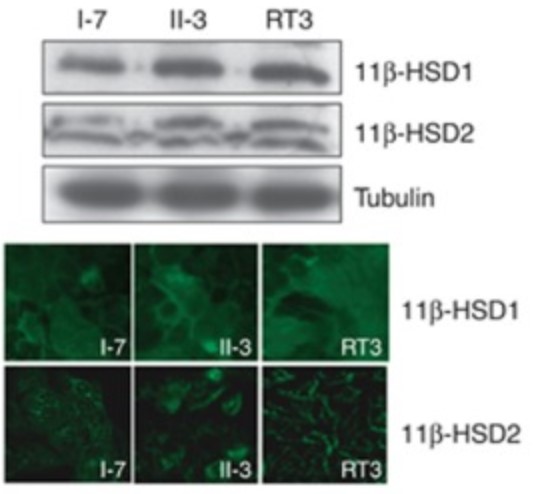
Fig1. Western blotting and immunofluorescence were undertaken to investigate the expression of 11β-HSD1 and 11β-HSD2 proteins.
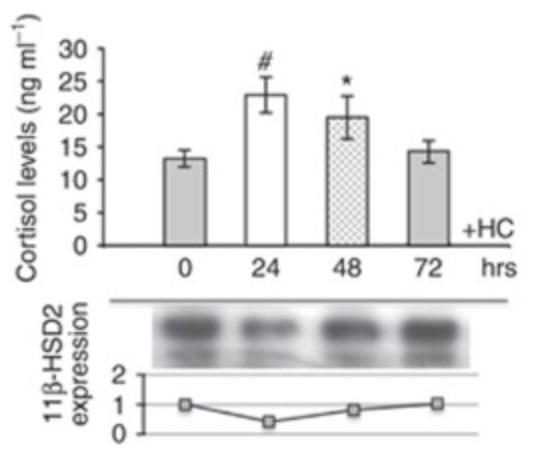
Case study 2: Yuki Nouchi, 2023
Maternal fructose consumption increases blood corticosterone levels in rat offspring. However, the underlying mechanism of action remains unclear. To elucidate the molecular mechanism, female Sprague Dawley rats received HFCS solution during gestation and lactation. The male offspring were fed distilled water from weaning to 60 days of age. The activities of GC-metabolizing enzymes (11β-Hsd1 and 11β-Hsd2) in various tissues (i.e., liver, kidney, adrenal glands, muscle, and white adipose tissue) and epigenetic modification were investigated. 11β-Hsd2 activity decreased in the kidney of the HFCS-fed dams. Maternal HFCS-induced elevation of circulating GC levels in offspring may be explained by a decrease in 11β-Hsd2 activity via renal miR-27a expression. The present study may allow us to determine one of the mechanisms of GC elevation in rat offspring that is often observed in the developmental origins of the health and disease (DOHaD) phenomenon.

Fig3. Effect of maternal HFCS intake on 11β-Hsd2 activities in the liver, kidney, adrenal glands, muscle, and WAT of offspring at PD60. Metabolite levels were determined by HPLC.
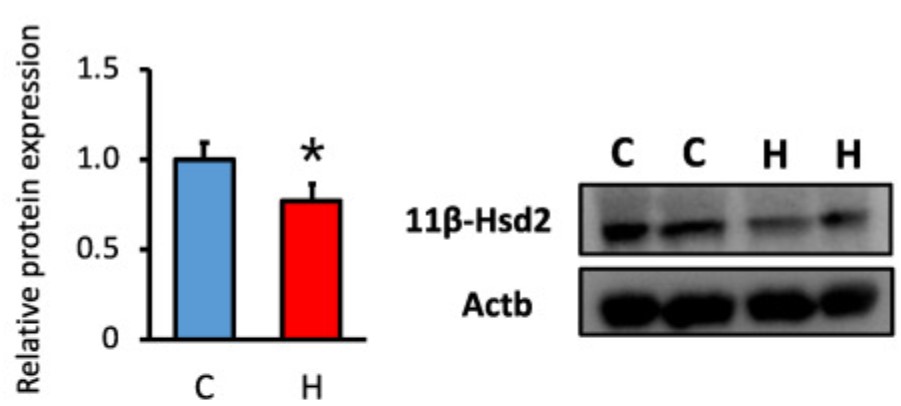
Quality Guarantee
High Purity
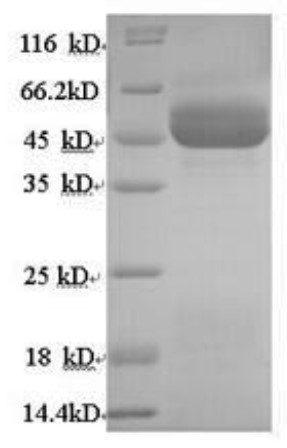
Fig1. SDS-PAGE (HSD11B2-14161H) (PROTOCOL for western blot)
.

Fig2. SDS-PAGE (HSD11B2-2257H) (PROTOCOL for western blot)
Involved Pathway
HSD11B2 involved in several pathways and played different roles in them. We selected most pathways HSD11B2 participated on our site, such as Steroid hormone biosynthesis,Aldosterone-regulated sodium reabsorption, which may be useful for your reference. Also, other proteins which involved in the same pathway with HSD11B2 were listed below. Creative BioMart supplied nearly all the proteins listed, you can search them on our site.
| Pathway Name | Pathway Related Protein |
|---|---|
| Aldosterone-regulated sodium reabsorption | PIK3CD,INS1,ATP1A2,NEDD4L,SLC9A3R2,MAPK1,ALPHA-ENAC,PIK3CG,FXYD2,ATP1B2 |
| Steroid hormone biosynthesis | CYP21A1,SULT1E1,SULT2B1,UGT1A3,HSD11B1,UGT1A7C,HSD17B12A,UGT5G1,CYP7B1,SRD5A1 |
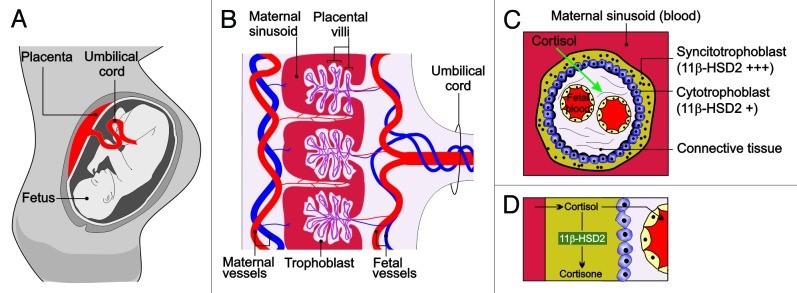
Fig1. The placental HSD11B2 shield. Excessive fetal glucocorticoid exposure during pregnancy results in low birth weight and abnormalities in a number of tissues. (Katie L Togher, 2014)
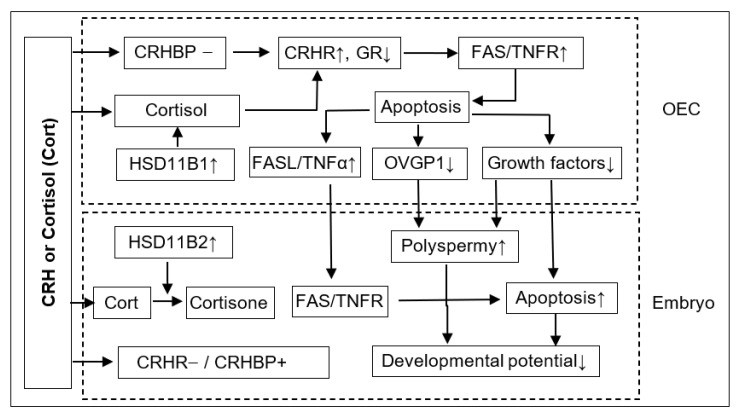
Fig2. Possible pathways by which corticotrophin-releasing hormone (CRH) or cortisol (Cort) impairs preimplantation development of pig embryos. (Jin-Song An, 2022)
Protein Function
HSD11B2 has several biochemical functions, for example, 11-beta-hydroxysteroid dehydrogenase [NAD(P)] activity,NAD binding,steroid binding. Some of the functions are cooperated with other proteins, some of the functions could acted by HSD11B2 itself. We selected most functions HSD11B2 had, and list some proteins which have the same functions with HSD11B2. You can find most of the proteins on our site.
| Function | Related Protein |
|---|---|
| 11-beta-hydroxysteroid dehydrogenase [NAD(P)] activity | HSD11B1 |
| steroid binding | CYP3A4,PAQR5A,ESRRGB,CYP21A2,PGRMC2,UGT1A1,PAQR8,PDIA2,ESRRGA,Ar |
| NAD binding | ME3,CYB5R3,GPD1,NDUFS2,LDHA,HSD3B4,GRHPRA,BDH2,NNT,GPD1B |
Interacting Protein
HSD11B2 has direct interactions with proteins and molecules. Those interactions were detected by several methods such as yeast two hybrid, co-IP, pull-down and so on. We selected proteins and molecules interacted with HSD11B2 here. Most of them are supplied by our site. Hope this information will be useful for your research of HSD11B2.
Resources
Related Services
Related Products
References
- Seltzer, J; Ashton, CE; et al. Gene and protein expression in pituitary corticotroph adenomas: a systematic review of the literature. NEUROSURGICAL FOCUS 38:-(2015).
- Appleton, AA; Lester, BM; et al. Examining the joint contribution of placental NR3C1 and HSD11B2 methylation for infant neurobehavior. PSYCHONEUROENDOCRINOLOGY 52:32-42(2015).



